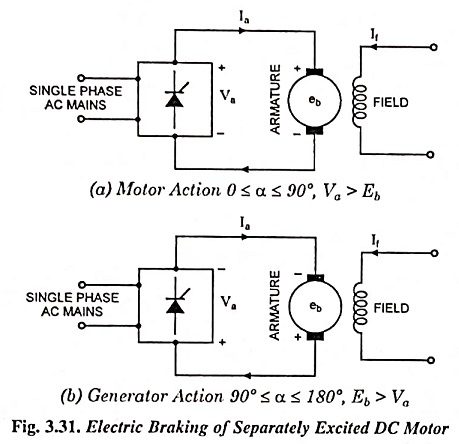Electric Braking of Separately Excited DC Motor:
The electric braking of separately excited dc motor is show in Figure 3.31. Figure 3.31 (a) illustrates a simplified representation of a single phase fully controlled rectifier supplying a separately excited dc motor. The polarities of voltages and directions of currents are also marked. The tiring angle of the rectifier is in the range of 0 ≤ α ≤ 90°.
For regenerative braking, the direction of power flow is to be reversed. The motor has to operate as a generator and supply power to converter which now operates as an inverter and feeds back power to the supply mains. The circuit diagram for this operation is illustrated in Fig. 3.31 (b). Since the inverter output is connected to the supply mains, natural commutation is possible. It is seen that direction of flow of current in both of the circuits is the same. It has to be so since the current through a thyristor can flow only from anode to cathode. For this mode of operation 90° ≤ α ≤ 180°.
It is seen from Fig. 3.31 that direction of induced emf (back emf) in circuit shown in Fig. 3.31 (b) is reverse of that in circuit shown in Fig. 3.31 (a). The reversal of induced emf can be had by any of the following methods :
- By reversing the direction of flow of field current. This provides forward regeneration.
- By reversing the armature terminals (keeping direction of rotation unchanged). This also provides forward regeneration.
- By driving the motor by an active load coupled to it in reverse direction. No change in connection is required. This provides reverse regeneration.
If the motor is supplied by a semiconverter regenerative braking is not possible because a semiconverter operates only in a first quadrant (i.e., cannot operate as an inverter). However, plugging is possible with both fully controlled and semiconverter. In this case it is necessary to reverse direction of induced emf by any of the above three methods. However, plugging needs an external resistor to be connected to the machine (to dissipate energy) and results in wastage of energy. Therefore, plugging is generally not employed in converter fed dc motors.
